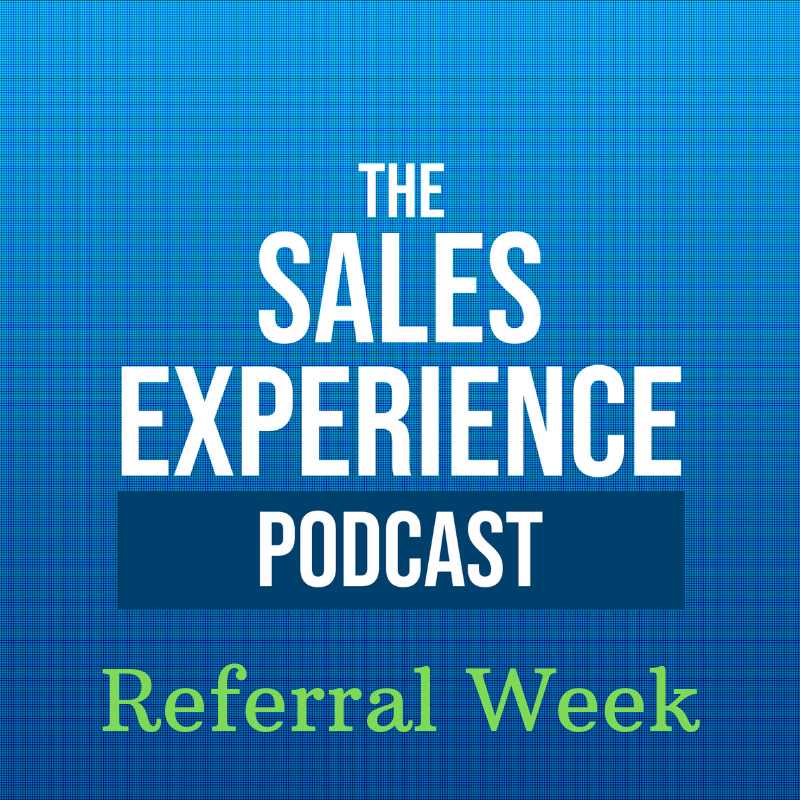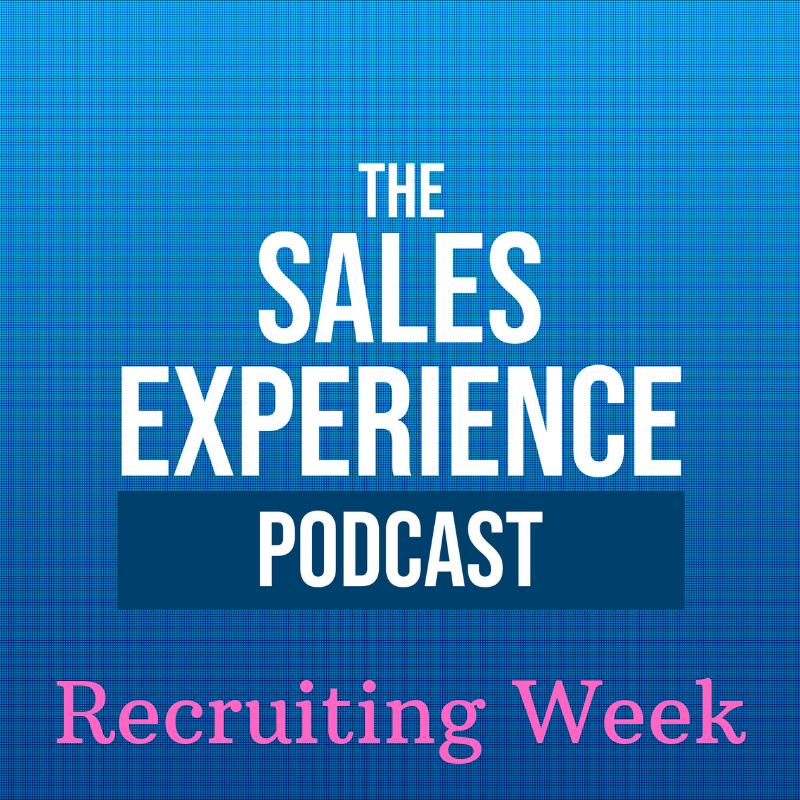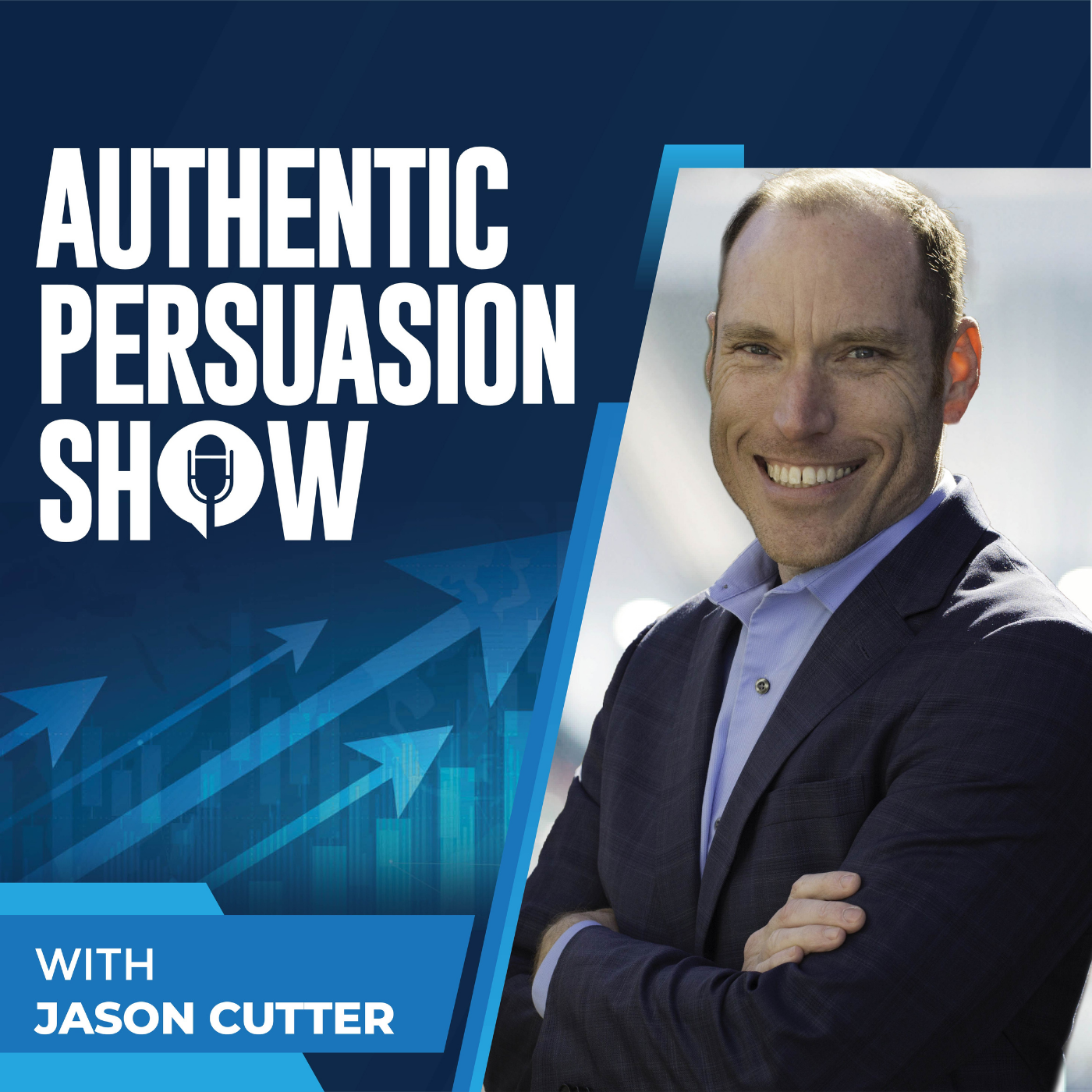Show Notes
This is the third segment of the conversation I had with Sean.
In Part 3, Sean and I talk about:
- Truth + Emotional Intelligence
- Keeping things simple to solve your prospect’s problem
- Understanding the five main groups of human behavior
- Knowing your metrics for moving forward (winning)
Download The Power of Authentic Persuasion ebook
Enroll in the Authentic Persuasion Online Course
Connect with Jason on LinkedIn
Connect with Sean on LinkedIn
Sean’s Bio:
Sean is a serial entrepreneur VC and co-founder of GrowthX and GrowthX Academy, with three successful exits, who has successfully grown dozens of early-stage companies across a wide variety of products and markets. He was recently named the #2 Online Sales Influencer and contributor at The Huffington Post. He’s now committed to working with countries, companies, entrepreneurs and those who want to work with them on building startup ecosystems and developing the next generation of leaders for the innovation economy.
E194 – Transcript
Jason: Alright. Welcome back to the sales experience podcast. Welcome to part three of my conversation with Sean Sheppard. As always, make sure to subscribe to the show so you can catch all these if you haven’t yet. Get part one and part two. Listen to those first so you can hear this continuation of our conversation, but without any further adieu, here we go. Sean and I diving into the third segment
Sean: Is because everybody wants that easy button that Apple provides you today but they don’t understand or Amazon, they don’t understand how hard and difficult that is and Amazon is the most valuable company in the world. They don’t make shit except all of us happy.
Jason: Yup. Make it easy and simple for us to get things that we want.
Sean: And so you want the optimal experience. That’s the optimal experience. You go into the conversation with a strong value hypothesis about how you think you can help someone and why you think that and then begin to have a conversation to validate that and then create less work and more value through the process, not the other way around.
Sean: All too often I see the complete opposite and if you are trying to pursue the truth, you have to get people to be honest with you and in today’s market, people will not tell you the truth if it creates more work or conflict. So you have to avoid both of those things. Create an environment where it’s easy for people to give you feedback. That’s part of the growth mindset. Feedback is a gift. Remove the word rejection from your vocabulary. Replace it with feedback and embrace it and behave in a way that allows people to say, yeah, I want to tell you the truth. I can’t wait to tell you. It feels good to talk to someone about these things. That emotional intelligence, care attribute and developing that emotional intelligence aspect of who you are is a critical part of that. But that’s an ongoing experience.
Sean: You can’t just do this stuff every time you feel like it or you think about it every single day. You need to be learning. You need to set aside time. Don’t listen to the freaking radio on the commute. Pull up the podcast like sales experience. Right? Or something like that. Learn something new. There’s no distinction in the innovation economy between personal and professional development. Do you want to be a great professional? You’d be a great person and you focus on that and you will get there. That’s my sales professional.
Jason: Right. So it’s interesting too that you’re talking about making it easier and not harder. I do see that a lot where companies, they don’t quite understand. I mean they think it’s easy cause they’re in it, right? They’re product designers, they’re engineers, they’re creators. They think it’s easy because in their mind it’s all simple.
Jason: They created it, they know how it works, they over-engineer it, but it’s still, it all makes sense in their brain and it solves a problem that they are excited to focus on and not thinking about the end-user. And then the salesperson is taking that and trying to sell that and overwhelming that prospect, that potential customer, which like you mentioned early on, the lizard brain is what motivates and drives a lot of us and that lizard brain, that primal brain is still imagining a hundred thousand years ago in a cave where afraid of change and buying something has changed and if you’re causing somebody to have to make a change, which is the sales process in a nutshell, and it’s going to be more difficult to get them to see how it improves their lives. Just because you’re excited doesn’t mean anything, then you’re going to have a tough go at it.
Sean: I’m glad you brought that up. Especially the word change. I tell all of our companies and anybody who listens when I do these workshops and keynotes around the world and all the rest is your number one competitor isn’t some other company or some incumbent. It’s the resistance to change. People naturally do not like or want change. And so when you’re taking something someplace new, you have to recognize that and only focus on working with people who share an innovator or early adopter mindset. Stay away from the mainstream in the skeptics and the laggards because they will eat up your resources but never deliver anything in return. And you have to be ruthless with your own time and how you share it and who you invested in because you don’t have a lot of time. You do no one any good, including yourself in your own family and those that you support much to say nothing of the marketplace itself by wasting your resources in areas that aren’t going to help you stay alive.
Jason: Yeah, and that’s very important to keep in mind as you’re talking about the stage of which accompanies at. So if nobody knows who you are or your product or your service, maybe you’ve created something new, there’s no brand awareness, maybe you don’t have a lot of social proof. You need to find those people who would like to wait outside of a store for hours to be the first one to buy that thing, to say that they bought that thing right when they could have waited a week and paid probably less and not had to wait.
Sean: So Geoffrey Moore calls it everybody who was interested. Again, the dynamic of taking a product to market for the first time needs to read Geoffrey Moore’s crossing the chasm or at least get the book summary and understand the five communities of human behavior and how they respond to risk and change and what you just described as the innovator.
Sean: That’s the person that goes out and buys the latest greatest thing. Even though it’s twice as expensive as it will be in a year and half as good as it will be once all the bugs are worked out. Most people in business, however, don’t have budgets and there’s a reason they don’t have budgets because people don’t trust them. That’s right. But you know what they are great at? they’re great at providing product feedback and they’re very, very useful early on. So when you’re working on features and functions and use cases and trying to understand how people are going to use your product or service, that’s where it’s most effective. But the people that are gonna help you the most are the early adopters. The early adopters are the people that have a strategic interest in helping you become successful because they see an order of magnitude change or transformation in their own life, in their own world.
Sean: If you succeed with them and they have budgets, they may not have big ones, but that budget’s big enough to build a business and there are enough of them. Now they’re, you know, typically you’re talking about collectively innovators are about one in seven, one at eight people, and early adopters are about one five people. So you’re talking about less than 20% of the market. And we’re not talking about organizational psychologists, we’re talking about individual psychologists. So as it gets complex and you’re selling into multiple people in a large enterprise, right? The average enterprise sale is about seven influencers involved in making decisions. Only two of those seven, just statistically speaking, would even meet the pre chasm, profile that you should be looking for as part of what we call your initial customer profile, which is a very different thing than your ideal customer profile in three or five years.
Sean: And that’s one of the dynamics that companies and founders have to struggle with. They go out to their investors and they go out into the world and they say, if we get this much of this market, this is what we’re going to be worth. And this is how this all works. That assumes a lot. That assumes that you’ve crossed that chasm and that you’ve gotten innovators and early adopters. Well, you can’t get there without them because the mainstream will not buy from you until they have referenceable use cases from other mainstream players. And they’re not going to get those until you are in a place of maturity with innovators and early adopters even attempt that. So it’s very important to identify those people, flag them early and often and only work with them. And if they don’t exist in an account or an opportunity right now, move on.
Sean: Because the last thing you want us to spend 6, 8, 10, 12 months on a deal that just goes dark. It never goes anywhere.
Jason: And fighting those, you know, late adopters and the people in the middle who literally need tons of convincing and they’re not going to be the first one to take the risk and they’re not going to be the one to put their neck on the line without valid proof. You’re going to spend all your time convincing them when you don’t have the time or the resources.
Sean: Like the old adage you, no one ever got fired for hiring IBM. And that’s fine. And so if you take that scenario that we just talked about and you played that out, hopefully now people will understand why knowledge, skills, and behaviors and attributes necessary to be successful in this economy are what they are.
Sean: Because in order to identify those people, you have to have strong business and market accuracy. You have to have strong emotional intelligence and great communication skills to be able to articulate to people to get their attention. You have to be an amazing cross functional communicator between the market and the product team and everybody else who’s involved in learning from that. You have to be able to embrace ambiguity that you have to have a love for helping people get what they want and you have to be strategic enough in your mindset and your thinking to look beyond not just the person that you’re trying to help, but how they’re measured in their role and how their boss’ and their bosses’ boss and their boss’s boss’s boss and their investors and then their customers and so on, all the way through to see the forest through the trees.
Sean: Because if you can’t do that, your chances of being successful in this area with limited time, money, resources go dramatically down.
Jason: Yeah. It’s interesting because the clients that I work with, the salespeople are just thinking about how their product solution can help that business. Right, and they’re thinking very narrow. I’ve been training people and telling them, what does your prospective customer, that individual at that company, what keeps them up at night, what wakes them up at two in the morning worried or wondering what their boss is going to call them out on or ask them about or could, you know, push them on at any moment and how can you solve that to make them the hero, right? And then just keep pushing that up the line instead of thinking, well, I have this thing that’s amazing and you should want it. Right? Think about that other person.
Sean: It’s what I call finding fit. Everything is about finding fit. At this stage, we’re not trying to sell anything to anybody. What we’re trying to do is seek fit. See if you’re a startup and you have one person responsible for building a product and another person responsible for building a market, how many people can you actually freaking talk to everyday? Not many. No. So in what metrics are going to guarantee that you get to that next round of money or that you get to break even so you can stay on the field longer or some interim step? Can I get two or three paid customers so that I can demonstrate that whatever it is, we call it a market milestone. You establish a market milestone by reverse engineering your funnel from the bottom up. Number one, you define an organizational objective. You turn that into a definable win.
Sean: Like I said, maybe three proofs of concept that are paid, maybe three free pilots, maybe converting free customers to pay customers, maybe doing 30 customer interviews with key profiles that you’ve identified or personas you’ve identified. I dunno picky right? Yeah. Maybe it is a revenue number, but it’d be based on something thoughtful though is predicting revenue results and forecasting revenue on a future when you don’t have a past is bullshit and a waste of everyone’s time. Yeah, so it needs to be traction-based for it to actually mean something. That’s why I say like the number of proofs of concept. I say I need three customers with this profile over the next six months, and you assign a deadline timeline to it and then you build your funnel, right? I need X number of qualified opportunities to do that. I need X number of qualified conversations to do that.
Sean: I need X number of qualified prospects to reach out to to do that. Right? And so when you’re doing that, you recognize that, alright, everything I’m doing is a hypothesis I’ve constructed based on a lot of thoughtful research and interaction and experience to determine that this might be the ideal initial customer profile and proof of concept necessary to meet those needs. So every conversation you’re having in the market needs to be centered around whether or not this person or this entity or this opportunity is actually a fit. You’d have to have a mindset of disqualifying people out of your funnel, not a mindset of qualifying. And you need to be okay with moving somebody out of your qualified opportunities and into your nurture framework or what we call it, nurture and opportunity framework, where we take them out of the opportunity pipeline qualified ops, and we put them into a qualified nurture pipeline.
Sean: It says maybe one day down the road because they’re a mainstream customer, right, and they’re not going to give us a list. Now we know that they may say otherwise, but I’ve been through this. There’s no point right now cause all I need are three customers. I just need three.
Jason: You need to find those three innovative or early adopters.
Sean: Absolutely. So I’m going to be tight on fit, right? This is all about establishing criteria. This is why I call the mindset not selling products to customers, but recruiting partners. You need to have a recruitment mindset. When you’re taking something, someplace in it, you have a reality and you have a vision. You share the vision, you’re honest about your reality and early adopters and innovators. We’ll meet you in that Venn diagram if you share it with them in an honest way. The ones that will nurture themselves closer to you will understand, will absolutely buy into your vision, but also respect your reality and be willing to invest the two things that matter more than anything else at this stage.
Sean: The time and the truth. That’s all I want from you. I want time and truth. I want the time of you and or X number of people in your team and I want them all to tell me the truth and if you guys do that, I promise you’ll get what you want.
Jason: Alright, everybody, that’s it for part three. Thank you so much for listening. I appreciate if you’re listening to these episodes, if you’re tuning in, if you’re listening to this conversation, Sean and I have because hopefully, that means either you’re on the same mission, the same path as us in building the right sales experience for success for companies and for customers, or you’re looking at sales or you’re looking at how you change your sales experience and you’re looking for tips and this is the vehicle to help you get there. Make sure to subscribe. You can also go to cutterconsultinggroup.com to find the episode, the show notes, the links, the transcript. As always, keep in mind everything in life is sales and people remember the experience you gave them.
![[E194] Growth Through Sales with Sean Sheppard – Part 3 of 4](https://episodes.castos.com/salesexperiencepodcast/images/Sean-Sheppard-Cover-Image.png)


